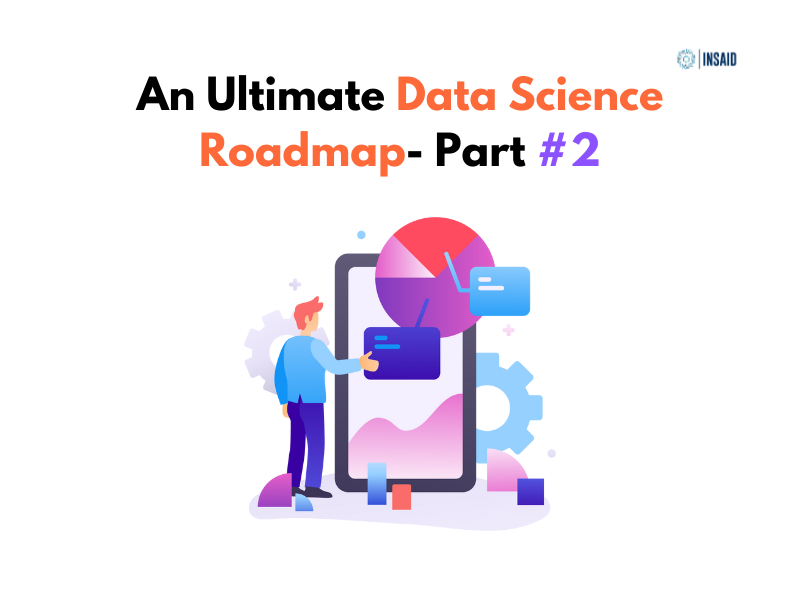This is a 2 part blog series that will provide you with a comprehensive data science roadmap that can aid your learning, helping you succeed in a world loaded with data. Make sure to stay read Part-1 as well!
So let’s continue to understand the rest of the steps in the journey towards becoming an effective Data Scientist.
Step 4: Learning the Key Tools for ML
There exist some basic and advanced machine learning tools that you need to learn & adapt yourself with. Some of the most important ones are listed below. These skills can be of immense value in your overall data science roadmap:
1. Exploratory Data Analysis & Data Cleaning: Before moving on to the ML tools, you need to be well versed with what EDA & data cleaning is. EDA or exploratory data analysis, is a way of studying the datasets to summarize them into a visual format. Data cleaning is the process of detecting & correcting errors, and ensuring that the data is free of errors.
The cheat sheet below can help you get started with EDA now.

2. Feature Selection & Engineering: This should typically be your next step in learning ML. This uses domain knowledge to obtain the features from the data, which in turn helps with improving the performance of ML algorithms. So, if you are willing to gain expertise in the ML domain, you need to learn about feature selection & engineering.
3. Model Selection: Out of all the statistical models, you will need to select one model that is well-suited for your problem. These are some of the statistical models that you can go with:
- Linear Regression: It is an algorithm of supervised machine learning, where the slope is constant & the predicted output is continuous.
- Logistic Regression: It is an algorithm for supervised learning classification that is used to predict the probability of a target variable. It is typically used for classification purposes.
- Decision Trees: This generally uses a decision tree to form assumptions & conclusions about the target values. It is one of the most common approaches of predictive modeling used in statistics & machine learning.
- K-Nearest Neighbor (KNN): It is one of the most simple supervised machine learning algorithms that can help with resolving regression & classification problems. It is quite easy to comprehend and learn. But it has a few drawbacks.
- K-Means: This is an unsupervised learning algorithm that units the unlabeled sets into diverse clusters. Where K represents the numeral of the centroid. This cheat sheet from Stanford university can help you with learning about K-Means.
- Naïve Bayes: It is one of the algorithms for supervised learning that helps in solving classification problems. It is considered one of the most successful algorithms because of its nature to create fast ML models that can help with making predictions. Here you can find more about Naïve Bayes.
- Dimensionality Reduction: A process of transforming the high-dimension space to a low-dimension space to maintain the meaningful properties of data. Learning dimensionality reduction is an important skill that every data scientist must possess.
- Random Forests: It is an ensemble learning method for classification, regression, and other task purposes. It includes drawing multiple decision trees at a time & outputting the class that is the mode of all. Dive deep with this amazing guide by Berkley University.
- Gradient Boosting Machines: One of the most leading techniques to build predictive models. It helps to deal with regression & classification problems and creates a prediction model in the form of an ensemble of the weak prediction models.
This guide can help you get started with Gradient Boosting Machines.
- XGBOOST: This tool specifically helps with executing the gradient boosted decision trees devised for speed and performance.
Find answers to what is XGBOOST, how to build an intuition for it, and much more with the guide here.
- Support Vector Machines: These are supervised learning models that are coupled with associated learning, they aid in evaluating the data for regression & classification analysis.
4. Model Evaluation: Moving towards the last step of machine learning, model evaluation, it generalizes the accuracy of the model based on the future data. It typically uses two methods, holdout & cross-validation.

Step 5: Profile Building
Building a profile on GitHub is an important task that every data scientist must complete. It is one of the most effective ways for a data scientist to gather all the code of the projects they have undertaken. It showcases your code and projects undertaken and shows how long you have been practicing data science.
Get started by checking this cheat sheet on GitHub.
To gain more knowledge in the data science domain, start following different YouTube channels. Our YouTube channel can surely be a good start for you.
Step 6: Prepare for Data Science Interview
You need to know all those key data science concepts that can help you ace your interviews. With our Data Science Interview questions Ebook, you can prepare yourself for the interviews.
So finally, instead of trying to learn all the skills required to be a data scientist endlessly, pick a problem that inspires you or bees relevant to your domain. Try to solve that problem using the data science skills, only pick up the skills necessary to solve that problem. As you solve more problems, you will learn more skills along the way.
 Pin
PinNow that you have a fair idea of the initial steps you need to follow, you are ready to win the world! Check out our blog page to find out more!
Also check out accredian.co for a range of easy and affordable programs for Data Science.






